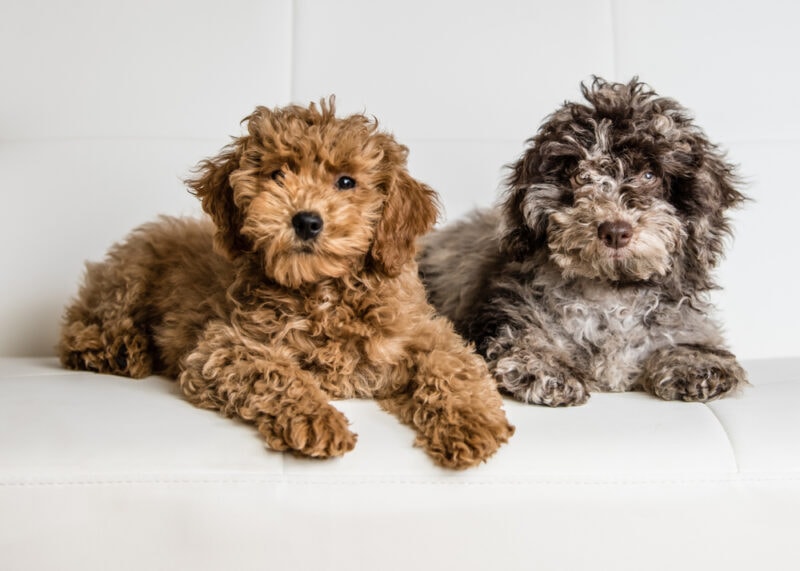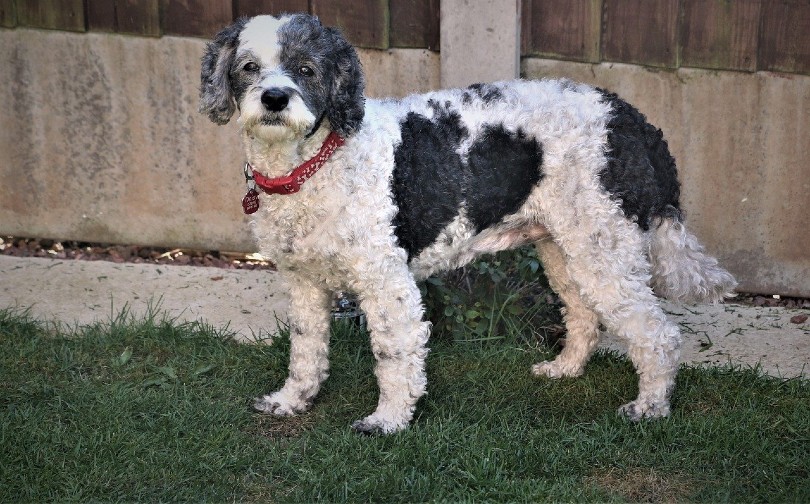Recently, there has been an increase in the number of Merle Cockapoos available for adoption. These dogs have a very interesting coloration that many dog owners are drawn to. However, everything isn’t as it seems with this breed.
Neither Cocker Spaniels nor Poodles (the two breeds that make a Cockapoo) come in a merle coloration. Therefore, a Cockapoo can’t come in a merle coloration, either. There are very few breeds that do come with a merle coat, and it often isn’t very common within these breeds, either.
There are several different ways the merle Cockapoo may appear. While a mutation can lead to a puppy suddenly becoming a merle, this is extremely rare. Instead, it is more likely that Merle Cockapoos aren’t Cockapoos at all. Instead, they are likely the result of another dog mixed in with the breed to bring about the merle coloration.
Shelties, collies, or the Australian Shepherd were likely used to bring about this merle gene. Likely, this was done to increase the “rarity” of the puppies and make them worth more money.
To completely understand how this merle coloration came to be and why they likely aren’t Cockapoos, let’s look at the Cockapoo’s history.
What is a Cockapoo?
A cockapoo is a mixed breed between a Cocker Spaniel and a Poodle—hence the name. This dog can inherit any trait from either parent. Therefore, you often don’t know what you’re getting until your dog is full-grown. Therefore, cockapoos are a bit of a coin flip.
However, this is one of the most popular mixed breeds out there. They are also one of the oldest to take off. In fact, these dogs are more popular than Poodles and Cocker Spaniels by themselves.
These dogs are bred to be companion animals. They are not commonly utilized for hunting, herding, or any work. Because they are very intelligent, they are also easy to train. However, their popularity isn’t entirely a good thing. Many breeders now see them as a way to make money since buyers often pay quite a bit.
While not all cockapoo breeders are bad, many puppy mills and backyard breeders have begun to produce them. Their breeding is not regulated by any sort of breed club. Therefore, breeders don’t have any regulations to look at (or even a definition of what a cockapoo is). There is no list of “approved” breeders out there.

Often, these dogs are bred entirely to sell. They aren’t shown in any kennel club, as they are not a recognized breed. Therefore, “novelty” and “rareness” often make puppies more expensive. Breeders aren’t working towards any breed standard, as with other breeds. Often, “rare” puppies can cost as much as $1,000—easily.
In the end, the merle coloration fits into this category. It is often advertised as a rare coloration, and the price tags for these dogs are often higher. However, neither Cocker Spaniels nor Poodles come in the merle coloration. Therefore, how any cockapoo ends up with this coloration is a bit controversial.
What is the Merle Gene?
The merle coloration is a particular kind of pattern found in certain breeds. However, how this coloration comes about is a bit more complicated than others. This coloration is known under several different names. For instance, you’ll hear it referred to as “dappled” or “harlequin” in certain cases.
In a dog with this coloration, the canine will have patches of a solid color mixed with a paler color. This color is created by a “defect” in the gene that causes pigmentation. Instead of the dog appearing all one color, some of the hairs don’t form correctly and the color appears paler.
Because of the defect, individual hairs can appear in multiple different colors. The whole coat can also vary in color, though it will usually be all one shade (such as all gray-black or red-brown).
With that said, this defective gene causes all sorts of different health issues. Pigmentation controls both eyes and ear development. Therefore, dogs with this coloration may have hearing issues and seeing problems.
There are a few select breeds that are known to display this coloration sometimes. For instance, Border Collies, Shetland Sheepdogs, Rough Collies, Miniature American Shepherds, Australian Shepherds, Great Danes, and Dachshunds can all inherit this gene. However, neither the Cocker Spaniel nor Poodle has this gene.
So, how does the cockapoo end up with this gene?

Can Cockapoos Have the Merle Gene?
A pure-bred cockapoo cannot have the Merle gene. While there is a chance that this gene may appear randomly through mutation, this would be extremely rare. Therefore, the only way to make a merle cockapoo is to mix the dog with something else too. Often, collies and similar dogs are utilized. However, this would not make the dog a cockapoo at all.
Merle coats are generally not popular for working animals. Therefore, these coats tend to be popular with dog owners looking for companion animals, as they can look quite unique. However, many who purchase these dogs don’t know the significant health problems that can come along with them.
When it comes to the merle coloration, color does matter. It simply isn’t a matter of how the dog looks. The gene of pigmentation can affect hearing and seeing. For instance, one common condition that is found almost exclusively in merle coloration is iris coloboma. Simply put, this eye condition is present at birth and causes the eye to not develop correctly. The severity differs a bit.
When two merles are bred together, more serious conditions can occur. When two merles are mixed together, about 25% of the puppies will have two copies of the merle gene. Usually, these dogs have both eyesight and hearing problems. Sometimes, the eyes or ears simply don’t form, and they often look like albinos.
Top 3 Unique Facts About the Merle Cockapoo
1. True Merle Cockapoos likely don’t exist
A random mutation can cause the merle gene. However, this is likely very rare. Instead, it is more likely that another breed was mixed in with the cockapoo to cause this coloration.
2. Merle Cockapoos are quite unhealthy
These dogs are very unhealthy due to the defect in their pigment development. Therefore, they are not typically recommended, and introducing this gene is looked down upon.
3. They are expensive
Because of their rarity, these dogs are quite expensive. Therefore, you have to plan on putting quite a bit of money down.
Are Merle Cockapoos Good Family Dogs?
While these dogs can be good family pets, there are certain considerations to take into account before purchasing one:
- These dogs are likely a mix between a cockapoo and another breed. Therefore, you don’t really know what you’re getting when you purchase one.
- Often, these dogs are quite expensive due to their perceived “rarity.” However, this price often isn’t worth it in the least.
- They have more health problems due to the defect in pigment development. Therefore, these dogs often have much higher vet bills.
- These dogs likely won’t live as long as dogs, as they are often quite unhealthy. It isn’t odd for them to be blind, deaf, or both. They can even have immune system and neurological problems.
Summary
Merle cockapoos may seem absolutely beautiful and like great family dogs. However, there are many potential problems with these dogs. For instance, the merle gene doesn’t exist in either Poodles or Cockapoos. Therefore, these dogs must be mixed with something else to cause the gene to be introduced into the breed.
Furthermore, the merle gene can cause all sorts of health issues. It is known to cause hearing and seeing issues, in particular. However, it can also cause neurological problems. These dogs cost more, and they have higher vet costs.
Featured Image Credit: Noviceshooter98, Shutterstock













